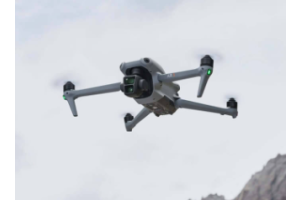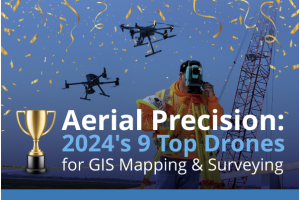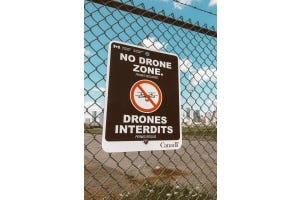
Autel Robotics has proven to be an exciting company in the field of unmanned flight systems since they were founded in 2014. Autel released its highly advanced EVO II line of compact drone solutions in 2020. The EVO II comes in five different models, so choosing the right one for your needs can be a challenge.
We will examine the differences and similarities between these powerful crafts and discuss specific use cases.
For visual reference, the Dronefly crew has also created an infographic showing the differences between the different drones in the Evo II series.
You can access the infographic by scrolling straight to the bottom of this page, or by clicking here.
Similarities
Each of the five crafts in the EVO II series features similar hardware and software specifications. Flying between 35 and 40 minutes at a maximum speed of 45 mph, and with a transmission range of 5.5 miles, the EVO II series of crafts are built for long flights, great distances, and high speed capabilities. In addition to omnidirectional obstacle avoidance, EVO II crafts feature Autel's Dynamic Track 2.0 technology. With this cutting edge technology, the EVO II will recognize an object in motion, model its trajectory, and follow it automatically while avoiding potential obstacles.
EVO II craft are largely distinguished by the payloads they can carry and the imaging capabilities they offer.


Autel EVO II
The EVO II is an entry-level, compact UAS system that still impresses despite its low price point.
Offering an 8K video recording system and 48 MP images, the EVO II delivers beautiful visuals. All this is possible with the 1/2 Inch CMOS sensor of the EVO II. Even though the EVO II lacks optical zoom, the 8K video and 48 MP still images allow users to digitally zoom into their footage before seeing any loss in image quality in post production.
You can get sharp videos and images in well-lit environments thanks to the f/1.8 aperture and auto ISO up to 6,400. Its limited ISO range and fixed aperture, however, will hinder the EVO II's ability to perform well in low light or in areas with dark shadows and bright highlights.
The EVO II is the perfect solution for aerial photographers, public safety workers, and industrial inspectors due to its sturdy design, long flight times, and strong imaging capabilities. The EVO II is a great pick and is a great alternative to the DJI Mavic 2 Pro if you want a drone to use personally or for use with other aerial imaging operations.


Autel EVO II Pro
The EVO II Pro is designed for professionals who prefer not to miss any details thanks to its 1 Inch CMOS sensor.
Akin to the previously mentioned EVO II, the EVO II Pro features amazing imaging capabilities in a lightweight, foldable form factor. Cinema-quality video and an unmatched dynamic range distinguish the EVO II Pro from the EVO II. With a 1 inch CMOS sensor (twice the size of the EVO II), the EVO II Pro captures more color and offers better shadow and highlight detail.
The most exciting aspect of the EVO II Pro is it’s low light capabilities. With an aperture between f/2.8 and f/11 and a maximum ISO of 12,800, this payload produces beautifully clear images in low light conditions. This camera's 6K video recording and 20 MP image record features ensure that sharp, beautifully detailed images can be captured in a variety of settings and conditions.
As with its little brother, the EVO II Pro was designed specifically for those who work in aerial photography. In addition, this drone becomes incredibly valuable for people who use orthomosaics, 3D maps, or 2D maps for construction, inspection, and agriculture because of its superior imaging capabilities and dynamic range.


Autel EVO II Dual and EVO II Dual 640T
High quality thermal imaging in a compact aircraft.
Autel offers the EVO II Dual to those who require thermal imaging capabilities for their flight operations. This craft combines a 320 x 256 FLIR thermal sensor with an 8K visual sensor in one payload, making it one of the best entry level thermal flight systems on the market. There are many industries that benefit from thermal imaging, including fire safety, search and rescue, police response, and many more. With up to 10 different color palettes, picture-in-picture viewing of thermal and visual images, and a 30Hz refresh rate, the EVO II Dual provides you with a complete range of imaging capabilities.
The EVO II Dual will be a great asset for professionals who need to take to the air quickly in order to search for individuals, monitor hot spots at fires, or conduct simple industrial inspection operations. However, for operations that require the absolute best thermal imaging, we recommend moving up to the 640T.
In addition to its visual imaging capabilities, the EVO II Dual 640T has a thermal sensor that is twice as powerful as its little brother. Thermal images can now be captured from up to 100 meters away thanks to its 640x512 thermal imaging resolution. It is useful for industrial inspections or other scenarios in which being too close to a subject is dangerous.
The EVO II Dual 640T is perfect for powerline, solar, and chemical inspection due to its radiometric capabilities. It can measure temperatures in flight, set temperature alarms, and apply different color profiles. This craft has detailed thermal imaging capabilities (even at significant distances), making it an essential tool for law enforcement during discrete operations.


Autel EVO II RTK
With the addition of the RTK Module, the EVO II is a must-have for complex inspection and survey missions.
As a complement to the powerful imaging capabilities of the EVO II Pro and EVO II Dual, the EVO II RTK series provides unrivaled accuracy and control.
Taking measurements with the EVO II will be centimeter-level accurate thanks to its ability to use both RTK (Real-Time Kinematics) and PPK (Post-Processed Kinematics). In order to determine your craft's location, RTK and PPK use GPS satellites and powerful base stations. This information allows users to record satellite observation data, camera exposure parameters, and other information. By saving flights and recreating them, you can monitor subtle changes over time.
With the precision of the RTK series and the power of radiometric thermal imaging, temperatures can be detected from 5 meters away within three degrees Celsius. The Evo II RTK is therefore one the best compact drones for industrial inspection operations, where even the smallest temperature differences can cause serious problems.
Surprisingly, the addition of the RTK module has no significant impact on the flight time or maximum speed of the EVO II. This craft's RTK module makes it a perfect tool for mapping, photogrammetry, and large scale industrial inspections.


The Autel Evo II Enterprise Series
This series is a premier choice for large-scale operations.
And finally, let’s talk about the ultimate EVO II drones, the Enterprise Series. While it’s true that the other Autel Evo II drones can also excel in enterprise operations, the Enterprise series drones have additional features and upgrades that make them especially suitable for large-scale operations. Among the drones in this series are the Autel Evo II 640T Enterprise and the Autel Evo II Dual R Enterprise. These drones feature a slightly upgraded body for a more durable build and the video transmission range is extended from 5.5 miles to 8 miles. However, the big difference is the ability to add modular accessories to the top of the drone. The included modules are a beacon for night flying, a loudspeaker for communication with people on the ground, and an optional RTK Module for centimeter-level accuracy during mapping missions, just like the EVO II RTK series. In addition, you’ll be able to see incoming air traffic around you while flying, thanks to the ADS-B receiver. The Enterprise series comes with your choice of cameras, which include the 6k 1-inch sensor, or your choice of the 8k camera with 640T dual camera or with the American-made FLIR camera. Additionally, Enterprise series drones come with the Smart Controller, which provides a large display, high brightness for viewing under full sun, and does not require a smartphone or tablet to operate.


What’s the Deal With the V1 and V2 Distinction?
As many may already know, the global chip shortage has made it difficult for companies like Autel to continue producing products as before. We’re talking about the first version of the EVO II, Smart Controller, and Live Deck. As a result, a second version of these platforms has been produced.
With the V2 aircraft now available for purchase, old and new drone pilots alike may be wondering what the change means for them.
Here are some key points to consider:
1. A glance at the top of your aircraft shell can tell you whether it uses a V1 or a V2 controller. On a V2, you will see the "V2" label between the top obstacle avoidance sensors. On a V1, there is no label.
2. It is not possible for V2 remote controllers to communicate with V1 aircraft or vice versa. The payloads remain interchangeable.
3. Cross-compatibility is maintained for batteries.
4. Live Deck is not compatible with the EVO II v2 chipset. Nonetheless, Autel is working on an alternative streaming solution for future release.
5. The Autel Explorer App is used by both the V1 and the V2 controllers.
6. In addition, two versions of Autel's Smart Controller were made due to the global chip shortage. It follows the same logic - V1 Smart Controllers are only applicable to V1 EVO II aircraft, and V2 Smart Controllers are only applicable to V2 EVO II aircraft.
7. The one-year manufacturer's warranty remains the same for all versions of the EVO II. AUTEL will continue to support both versions of the EVO II.
8. n the event that parts are not available for your version of the EVO II, Autel will repair your product and/or replace it with a product of equivalent value (Subject to additional warranty conditions).
9. Retailers often refer to V1 products as "single-band" and V2 products as "dual-band".
10. At this time, Autel is NOT accepting V1 drone trade-ins.


Conclusion on the EVO II Series
The Autel EVO II models are compact, easy to fly, and offer powerful imaging capabilities. Autel has created compact drone systems that will fit your needs, regardless of your experience with drones or your operation's size.
Dronefly carries all the EVO II products you need to turbo-charge your enterprise operations. Contact us today for customized recommendations for your operational needs.
If you'd like to learn more about the Autel Evo II Series, check out our infographic and detailed explainer video below.
Autel Evo II Comparison Graphic









